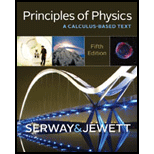
(a)
The unknown pressure, volume and temperature.
(a)
Answer to Problem 16P
The unknown parameters have been tabulated.
| State | |||
| A | |||
| B | |||
| C | |||
| D |
Explanation of Solution
Consider the first adiabatic process along D through A
Write the equation for adiabatic process,
Here
Rearrange (I) in terms of
Write the ideal gas equation
Here
Substitute for
Consider the isothermal process along C through D.
Therefore,
Here,
Write down the equation for isothermal process.
Here
Substitute (II) in (V)
Consider the adiabatic process along B through C.
Here
Substitute (VI) in (VII)
Consider the isothermal process along A through B
Substitute (IX) in (VIII)
Conclusion:
Substitute
Substitute
Therefore,
Substitute
Substitute
Substitute
Therefore,
| State | |||
| A | |||
| B | |||
| C | |||
| D |
(b)
Energy, work done and change in internal energy involved in each steps.
(b)
Answer to Problem 16P
Energy, work done and change in internal energy has been tabulated.
| Process | |||
| A to B | |||
| B to C | |||
| C to D | |||
| D to E |
Explanation of Solution
Consider the isothermal process along A through B.
Write the equation for energy transfer
Here
Then by first law of thermodynamics
Here
Consider the adiabatic process along B through C where
Here
Substitute
Consider the isothermal process along C through D
Consider the adiabatic process along D through A.
Conclusion:
Substitute
Substitute
Substitute
Substitute
Therefore
| Process | |||
| A to B | |||
| B to C | |||
| C to D | |||
| D to E |
(c)
Efficiency of the engine.
(c)
Answer to Problem 16P
Efficiency is
Explanation of Solution
Write the equation for efficiency
Here
Conclusion:
Refer sub part b and substitute
Efficiency is
(d)
To prove that the efficiency is equal to Carnot efficiency.
(d)
Answer to Problem 16P
The efficiency is equal to Carnot efficiency.
Explanation of Solution
Write the equation for Carnot efficiency
Here
Conclusion:
Substitute
Thus, the efficiency is equal to Carnot efficiency
Want to see more full solutions like this?
Chapter 18 Solutions
Principles of Physics: A Calculus-Based Text
- Lab 8 Part 3 PHET Wave Interface simulation. I am having trouble with this part of the lab.arrow_forwardMick and Rick are twins born on Earth in the year 2175. Rick grows up to be an Earth-bound robotics technician while Mick becomes an intergalactic astronaut. Mick leaves the Earth on his first space mission in the year 2200 and travels, according to his clock, for 10 years at a speed of 0.75c. Unfortunately, at this point in his journey, the structure of his ship undergoes mechanical breakdown and the ship explodes. How old is Rick when his brother dies?arrow_forwardHi, I have canceled, why did you charge me again?arrow_forward
 Physics for Scientists and Engineers, Technology ...PhysicsISBN:9781305116399Author:Raymond A. Serway, John W. JewettPublisher:Cengage Learning
Physics for Scientists and Engineers, Technology ...PhysicsISBN:9781305116399Author:Raymond A. Serway, John W. JewettPublisher:Cengage Learning Principles of Physics: A Calculus-Based TextPhysicsISBN:9781133104261Author:Raymond A. Serway, John W. JewettPublisher:Cengage Learning
Principles of Physics: A Calculus-Based TextPhysicsISBN:9781133104261Author:Raymond A. Serway, John W. JewettPublisher:Cengage Learning Physics for Scientists and Engineers with Modern ...PhysicsISBN:9781337553292Author:Raymond A. Serway, John W. JewettPublisher:Cengage Learning
Physics for Scientists and Engineers with Modern ...PhysicsISBN:9781337553292Author:Raymond A. Serway, John W. JewettPublisher:Cengage Learning Physics for Scientists and Engineers: Foundations...PhysicsISBN:9781133939146Author:Katz, Debora M.Publisher:Cengage Learning
Physics for Scientists and Engineers: Foundations...PhysicsISBN:9781133939146Author:Katz, Debora M.Publisher:Cengage Learning Physics for Scientists and EngineersPhysicsISBN:9781337553278Author:Raymond A. Serway, John W. JewettPublisher:Cengage Learning
Physics for Scientists and EngineersPhysicsISBN:9781337553278Author:Raymond A. Serway, John W. JewettPublisher:Cengage Learning





